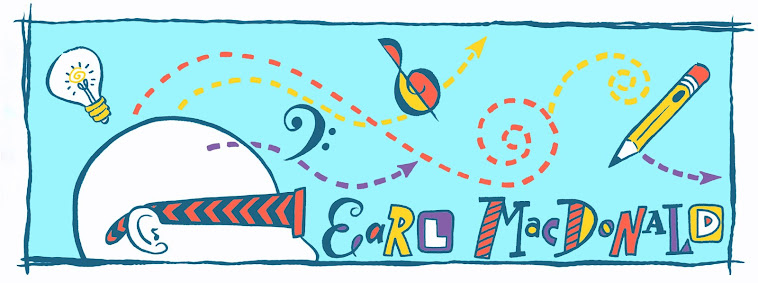I have become a huge fan of "little big bands." They typically range in size between nine and twelve instrumentalists, which gives an arranger the best of both words: the subtleties of a combo and the robust power of a full jazz orchestra. I use this format both with my professional band, the Hartford Jazz Society's New Directions Ensemble and with the UConn Jazz Ensemble, which I direct.
Working with a smaller-sized group (in comparison to the typical 17-piece big band) not only makes sense financially, it facilitates instruction in improvisation and musical interaction within university ensemble rehearsals, and makes the band more selective/elite.
Over the past decade I have been exposed to a wide variety of music written for the "pocket big band". I prepare the music of a single composer/arranger each semester with my university students. It has been fun to compare and contrast the writing styles of many different arrangers. This semester we are focusing on the music of Rob McConnell's 10tet.
Here is a list comparing the instrumentation used by several arrangers for little big band. I found it insightful to see the subtle differences between the groups.
If you know of any similar little big bands, please let me know by leaving a comment below. I am always looking for exciting new music to spark my imagination and to program with the UConn Jazz Ensemble.
Working with a smaller-sized group (in comparison to the typical 17-piece big band) not only makes sense financially, it facilitates instruction in improvisation and musical interaction within university ensemble rehearsals, and makes the band more selective/elite.
Over the past decade I have been exposed to a wide variety of music written for the "pocket big band". I prepare the music of a single composer/arranger each semester with my university students. It has been fun to compare and contrast the writing styles of many different arrangers. This semester we are focusing on the music of Rob McConnell's 10tet.
Here is a list comparing the instrumentation used by several arrangers for little big band. I found it insightful to see the subtle differences between the groups.
- Miles Davis Nonet: (Birth of the Cool, 1949-50)
1 alto sax, 1 baritone sax, 1 trumpet, 1 French horn, 1 trombone, 1 tuba, piano, bass, drums - Rob McConnell Tentet:
1 alto sax, 2 tenor saxes, 2 trumpets, 2 trombones, piano, bass and drums - Jim McNeely Tentet:*
3 reeds: alto sax (doubling soprano & flute), tenor sax (doubling soprano, alto, flute and clarinet), bari sax (doubling bass clarinet),
2 trumpets, 1 French horn, 1 trombone, piano, bass and drums

- Dave Rivello Ensemble: (12-piece band in Rochester, NY)
3 reeds (soprano sax, tenor sax, bass clarinet w/ doubles), 2 trumpets, 1 flugelhorn, 2 trombones, 1 tuba, piano, bass, drums - Joey Sellers' Jazz Aggregation: (11-piece band in California)
1 alto sax (doubling soprano sax, flute & clarinet), 1 tenor sax (doubling soprano sax, flute & clarinet), 1 bari sax (doubling bass clarinet & flute), 2 trumpets, 2 trombones, 1 bass trombone, piano, bass and drums.
- John Mills Times Ten: (Austin, TX)
1 alto sax (doubling soprano sax & flute), 1 tenor sax (doubling alto sax), 1 bari sax, 2 trumpets, 1 trombone, guitar, piano, bass, drums
- Gil Evans & Ten: (1957 recording)
1 soprano sax, 1 alto sax, 1 bassoon, 2 trumpets, 1 French horn, 1 trombone, 1 bass trombone, piano, bass, drums
- Fil Lorenz & the Collective West Jazz Orchestra (San Fransisco)
1 alto sax (doubling flute), 2 tenor saxes (doubling flute), 1 bari sax (doubling flute), 3 trumpets, 2 trombones, guitar, bass, drums
- Maynard Ferguson's Big Bop Nouveau:
original configuration: 4 trumpets, 2 trombones, 4 saxophones & rhythm section, plus Maynard
reduced configuration: 1 alto sax, 1 tenor sax, 3 trumpets, 1 trombone, piano, bass, drums, plus Maynard
If you know of any similar little big bands, please let me know by leaving a comment below. I am always looking for exciting new music to spark my imagination and to program with the UConn Jazz Ensemble.



I thought I posted a comment earlier, but its not showing up:
ReplyDeleteCheck out Jim Cifelli New York Nonet
From the 50s and 60s check out the Marty Paitch Dektet and Shorty Rogers And His Giants. Also a nice record "Art Pepper +11" with charts by Bill Holman (I think).
Beautiful! Thanks. Joe Lovano's nonet is another obvious one that I neglected to mention.
Delete"Art Pepper+11" was arranged by Marty Paich!
ReplyDelete